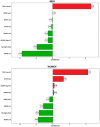Developing a quantitative estimate of muscle age acceleration by a novel phenotypic clock: cross-sectional study in healthy, middle-aged and older adults
- PMID: 40500122
- PMCID: PMC12245203
- DOI: 10.18632/aging.206269
Developing a quantitative estimate of muscle age acceleration by a novel phenotypic clock: cross-sectional study in healthy, middle-aged and older adults
Abstract
Sarcopenia is a progressive disease characterized by reductions in muscle mass strength and physical performance. Among the initiatives launched to increase awareness, the European Working Group on Sarcopenia in Older People (EWGSOP) is considered the most influential. This cross-sectional study was planned to develop, in healthy middle-aged and older adults, a novel predictor of sarcopenia based on the motor-functional and anthropometric tests derived from EWGSOP2, which were the primary outcome measures. Participants were tested for body composition, physical performance, blood biomarkers, and risk scores for major healthy issues. Muscle Age Acceleration (MAA) was modelled with Elastic Net regression to extract EWGSOP test mostly contributing to the musculoskeletal ageing trajectory. Two-hundred-fifteen participants were tested (118 women, 97 men; mean age; 66.0±7.3 years). Muscle Age was correlated with chronological age (r = 0.645; p < 0.001). Parsimonious modelling extracted TUG (β = 2.93; 2.48 - to -3.51), ASMM (β = -2.23; -2.99 to -1.67) and Handgrip (β = -1.12; -1.70 to -0.42) for men, and TUG (β = 2.69; 1.96 to 4.19), Handgrip (β = -1.27; -1.56 to -0.98), and Six-MWT (β = -1.15; -1.71 to -0.53) for women. According to MAA, three trajectories were identified: accelerated agers displayed higher risk for sarcopenia (19%), as compared to normal (9%; p < 0.0001) and decelerated (2%; p < 0.0001), paralleled by significant subclinical alterations of haemato-chemical markers in accelerated agers. MAA could validly identify accelerated agers with higher risk of sarcopenia, whereas PhenoAge detected subclinical haematochemical alterations. Longitudinal studies are needed to appraise the validity of this newly introduced predictor of sarcopenia and verify if accelerated agers are at higher risk for developing sarcopenia.
Keywords: EWGSOP; ageing; biological age; frailty; sarcopenia.
Conflict of interest statement
Figures




References
-
- Cruz-Jentoft AJ, Bahat G, Bauer J, Boirie Y, Bruyère O, Cederholm T, Cooper C, Landi F, Rolland Y, Sayer AA, Schneider SM, Sieber CC, Topinkova E, et al. , and Writing Group for the European Working Group on Sarcopenia in Older People 2 (EWGSOP2), and the Extended Group for EWGSOP2. Sarcopenia: revised European consensus on definition and diagnosis. Age Ageing. 2019; 48:16–31. 10.1093/ageing/afy169 - DOI - PMC - PubMed
-
- Lynch GS. Sarcopenia. In: Mooren FC, editor. Encyclopedia of Exercise Medicine in Health and Disease. Berlin, Heidelberg: Springer Berlin Heidelberg. 2012; 775–9. 10.1007/978-3-540-29807-6 - DOI
MeSH terms
Substances
LinkOut - more resources
Full Text Sources
Medical

